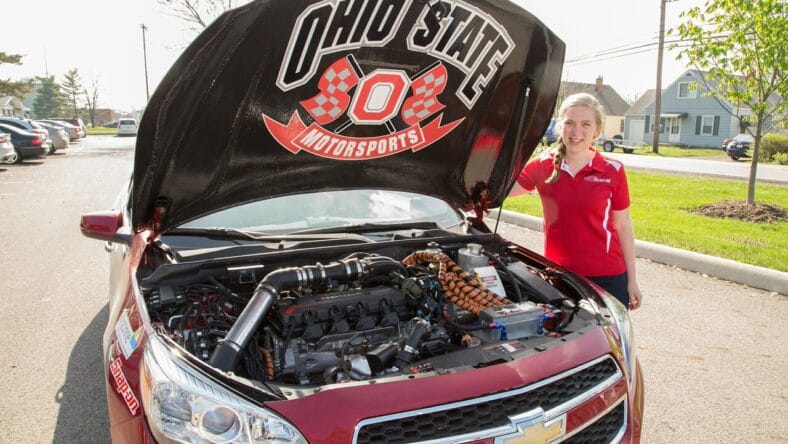What Drives Her: M.J. Yatsko, Grad Student Leading The EcoCAR 3 Program

Reimagining and re-engineering the Camaro for the EcoCAR 3 program.
How do you balance a love for sports cars with a passion for the environment? M.J. Yatsko, a graduate student at Ohio Sate University, could have the answer.

M. J. was recognized as an outstanding woman in engineering in the EcoCAR program. Previous winner from the Ohio State EcoCAR team, left to right Beth Bezaire, Katherine Bovee and Amanda Hyde
M.J., the team leader for the EcoCAR 3 program at OSU, has been involved in the technology competition since her high schools days, interning with EcoCar and then continuing as a team member though her undergraduate days at Ohio State.
The advanced vehicle technology competition, sponsored by General Motors and the U.S. Department of Energy, has been tasked to redesign and reengineer a Chevrolet Camaro. The goal is to make the Camaro more fuel efficient and better for the environment while still maintaining performance, safety and consumer acceptability.
Sixteen universities participate in the years-long competitions, and M.J. said Ohio State’s team stands out as one that has always had a lot of women. She acknowledged that this is relative to other teams; out of 30 members, at most 4 or 5 are women; “we are mainly engineers,” she said with a laugh. But the Ohio State team, unlike those at other schools, also has had former female team leaders.
A graduate student in Mechanical Engineering, M.J. oversees everything going on with the project, from mechanical design to project management to recruitment and technical focus.
M.J. said that recruitment of other women to the team is easier as a female team leader – and in fact when she first interned with the program, the team leader was a woman.
Making a difference – through engineering

Sarah Jadwin (EcoCAR 2 Communications Mgr) and M.J. at the Kansas City NASCAR race with the EcoCAR 2 vehicle.
Cars were in M.J.’s blood from an early age- her father is a car salesman. She was also always fascinated by engineering, getting involved in robotics from elementary school through high school. And with a passion for green and sustainable products, she said that EcoCar is the perfect intersection of all her interests: this is “exactly what I wanted to be doing.”
The EcoCar program is currently sponsored by General Motors and one of its results is training engineers to work in the automotive industry. M.J. said the program “has benefitted me; I’ve interned at GM for two summers” She said that a benefit to GM was that “when I started, I could jump right in.”
Multi-year competition: new cars, new ideas
M.J. said that the Department of Energy and different car companies sponsor the multi-year competitions; the current four-year competition will end after she graduates. Younger students will take over; “that’s why we try to get freshman and sophomores to join; we train them, then they can take over.”
A love for hybrids
At GM, M.J. worked on hybrids, helping out on the next generation Volt, testing on the Cadillac ELR. She has been able to further her interest in the environment, working on the energy side and different factors that go into electric vehicle range and mpg.
It’s “really cool for me working on cars not on market or not announced yet,” M.J. said. The Cadillac ELR she worked on was introduced recently and the 2016 Volt will come out later this year.
Balancing performance and fuel efficiency
In past competitions that M.J. was involved in, teams worked on a Ford Escape and Chevrolet Malibu. She said that because the current competition involves a Camaro, people very interested; “we are pulling in new people.” Some of the students who joined the team “wouldn’t think of hybrids at all.” The plan is to create an “ awesome hybrid that is also fun to drive.”
The Camaro competition is just under way, and M.J. said the process is one of design and evaluation for now; “we have to build our own vehicle, choose the powertrain, test electric and battery options.”
In year two, students will be give a 2016 Camaro so they can “do baseline testing and have something to compare it to,” she said. Once the Camaro is tested for drivability, “we take out every component – from the powertrain to seats and then integrate our own vehicle.”
M.J. said the major challenge is “maintaining performance using a downsized engine” so the resulting Camaro is a more efficient vehicle.
EcoCAR: the competition is not just for engineers
One of the interesting things about the EcoCAR competition is the integration of business and communications students into teams of engineers. M.J. acknowledged that most of the work is mechanical, but a communications team writes press releases about the work being done, and business students help the engineers consider the cost of the vehicles produced. The interdisciplinary approach is one that continues as the engineers go on to work in the automotive industry, so it is a particularly useful learning environment.
Despite her love for performance and fuel economy, M.J. said that as a graduate student, she drives an old car that “gets me from point A to point B.” But if she continues to work in the automotive industry, she will surely be driving a hot hybrid one day.
Coming up: shooting for a first place win
M.J. is heading the EcoCAR team at EcoCAR 3’s Year One Competition on May 29 in Seattle, looking for a second consecutive first place finish.


